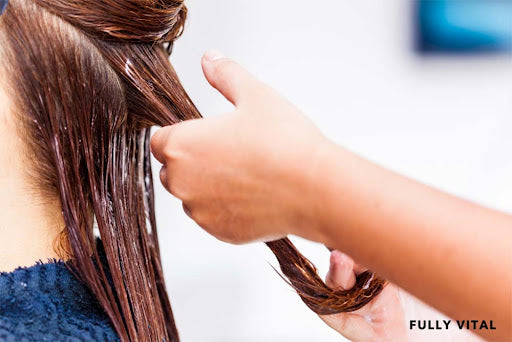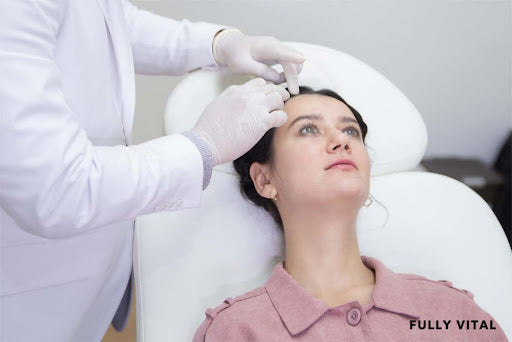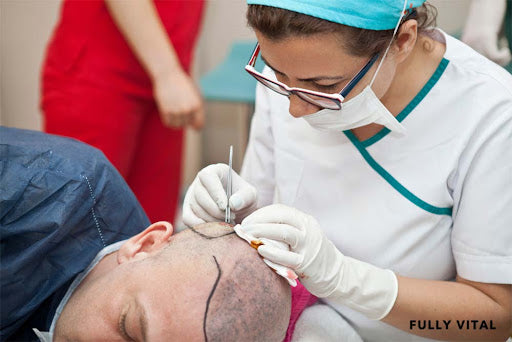
Thermal Reconditioning: A Game-Changer For Hair Growth
As a woman with a passion for beautiful and healthy hair, I understand the frustration that comes with struggling to stimulate hair growth.
Luckily, there’s a revolutionary technique called thermal reconditioning that can transform your locks into luscious strands.
In this article, I will walk you through everything you need to know about thermal reconditioning – what it is, why it's important, how it works, its benefits, any potential downsides, and alternative options.
Let's dive in!

I LOVE MY HAIR NOW
FullyVital hair serum and hair vitamins made tremendous improvements in my hair. I truly love my hair now.
Dorit S.,
What Is Thermal Reconditioning?
Thermal reconditioning, also known as Japanese hair straightening, is a professional hair treatment that can permanently straighten and smooth your hair.
By altering the structure of your hair using heat and chemicals, thermal reconditioning can help you achieve sleek and straight hair that lasts for months.

Why Is Thermal Reconditioning Important?
The importance of thermal reconditioning lies in its ability to transform your hair in a way that no other method can.
If you're tired of dealing with frizz, unruly curls, or unmanageable waves, thermal reconditioning offers a long-lasting solution.
It can give you the freedom to style your hair effortlessly, saving you precious time and energy in your daily hair care routine.
How Does Thermal Reconditioning Work?
The process of thermal reconditioning involves several steps.
Firstly, a specialized hair solution containing a chemical relaxant is applied to your hair.
This relaxes the hair follicles, allowing them to be reshaped.
Next, your hair is meticulously straightened using high heat flat irons.
This heat locks in the new shape of your hair, making the straightening effect permanent.
Finally, a neutralizer is applied to restore the pH balance of your hair and lock in the straightened structure.
What Are The Benefits Of Thermal Reconditioning?
Thermal reconditioning offers a plethora of benefits that make it an attractive option for women seeking to stimulate hair growth. Here are some key advantages:
- Long-lasting Results: Unlike temporary smoothing treatments, thermal reconditioning provides permanent results, typically lasting until new hair grows.
- Time-saving: With straightened hair, your daily styling routine becomes quicker and easier.
- Manageability: Bid farewell to frizz and unmanageable hair – thermal reconditioning leaves you with silky, smooth tresses that require minimal effort to maintain.
- Versatility: Even after thermal reconditioning, you can still enjoy various styling options. You can wear your hair straight or add curls using heat tools.
Are There Any Downsides To Thermal Reconditioning?
While thermal reconditioning is a game-changer, it's crucial to consider potential downsides before diving in. Here are a few things to keep in mind:
- Hair Damage: The chemicals and heat involved in thermal reconditioning can cause damage to your hair if not done properly or if your hair is already compromised. Consulting a professional stylist is essential to minimize potential damage.
- Maintenance: To maintain the straightened hair, you should avoid getting it wet, tying it up, or using any hair accessories for the first few days after the treatment.
What Are The Alternatives To Thermal Reconditioning?
If thermal reconditioning doesn't suit your needs or if you're worried about potential damage, there are alternative options to explore:
- Keratin Treatment: Keratin treatments help reduce frizz and make your hair more manageable, but they don't offer permanent results like thermal reconditioning.
- Home Remedies: Incorporating natural ingredients, such as coconut oil or aloe vera, into your hair care routine might help improve hair growth and minimize frizz.1 However, the results may not be as dramatic as thermal reconditioning.
- Professional Styling: Regular salon blowouts or using heat tools at home can temporarily give you the desired results without any permanent hair alterations. However, they require continuous maintenance.
What Is The Science Behind Thermal Reconditioning?
Thermal reconditioning is rooted in the science of altering the chemical structure of your hair.
Here's a simplified explanation of the scientific process behind thermal reconditioning:
Hair Structure and Bonds
The natural structure of your hair consists of protein strands held together by chemical bonds.
These bonds determine the shape and texture of your hair, whether it be straight, wavy, or curly.
Reshaping the Bonds
During thermal reconditioning, the chemical relaxant solution breaks the existing bonds in your hair.
With the application of heat from flat irons, the hair is reshaped into a straight pattern.
The heat helps to form new bonds in the straightened configuration.2
Permanent Effect
The newly formed bonds hold the straightened shape until your hair grows out. As your hair grows, the effect gradually fades away, requiring touch-ups to maintain the straightened appearance.
What Is The Impact Of Thermal Reconditioning On Hair?
Thermal reconditioning has a significant impact on your hair, providing several benefits that promote hair growth and overall hair health.
- Permanent Transformation: Unlike temporary treatments, thermal reconditioning offers a permanent change in the structure of your hair. This means your hair will remain straight until new hair grows.
- Silky Smoothness: One of the most noticeable effects of thermal reconditioning is the smooth and silky texture it imparts to your hair.3 Say goodbye to frizz and hello to effortlessly sleek and manageable locks.
- Improved Styling Options: Thermal reconditioning gives you the versatility to experiment with various hairstyles. Whether you prefer straight hair or want to create curls using heat tools, the possibilities are endless.
Is Thermal Reconditioning Safe?
Safety is a valid concern when considering any hair treatment, and thermal reconditioning is no exception. Here are some key points to consider regarding the safety of thermal reconditioning:
- Professional Expertise: It is crucial to entrust this process to a professional stylist experienced in thermal reconditioning. Their expertise ensures the treatment is performed correctly, minimizing the risk of potential damage.
- Potential Hair Damage: Although thermal reconditioning can yield amazing results, improper application or existing hair damage can lead to adverse effects. Prior consultation with a stylist and maintaining healthy hair are crucial for a successful treatment.
What Are Some Key Elements In Thermal Reconditioning?
Thermal reconditioning involves several key elements that contribute to its effectiveness.
Here are the main elements that make up this transformative hair treatment:
Chemical Relaxant Solution
A specialized hair solution containing a chemical relaxant is applied to your hair.
This relaxes the hair follicles and prepares them for reshaping.
High Heat Flat Irons
High heat flat irons, specifically designed for thermal reconditioning, play a crucial role in the process.
These irons are used to straighten your hair and lock in the new shape.
Neutralizer
After the straightening process, a neutralizer is applied to your hair.
This helps restore the pH balance and locks in the straightened structure, making the effect long-lasting.
How Do You Maintain Hair After Thermal Reconditioning?
Congratulations on your newly transformed hair! To ensure the longevity and health of your straightened locks, it's important to follow some proper maintenance techniques. Here are some tips:
- Avoid Moisture: For the first few days after the treatment, avoid getting your hair wet as much as possible. This allows the new shape of your hair to set and last longer.
- Heat Protection: Prioritize using heat protection products before styling your hair with heat tools, such as flat irons or curling wands. This helps minimize damage caused by heat exposure.
- Gentle Care: Opt for sulfate-free and gentle shampoos and conditioners. Avoid vigorous brushing or combing, and use wide-toothed combs or brushes specifically designed for detangling.
- Regular Trimming: Regular trims are essential to maintain the health and appearance of your hair. Schedule appointments with your stylist every 6-8 weeks to keep your ends looking fresh.
Discover the Miracle of Fully Vital Hair ProductsFully Vital is dedicated to helping you embrace the enduring beauty of your hair. Our hair growth solutions are backed by science and meticulously designed to reverse the effects of time, breathing new life into your locks and nurturing a stronger, more vibrant connection with your hair.
Join us on this journey to rediscover the vitality of your hair. Your hair deserves to look and feel its absolute best, and we're here to turn that into a reality! |
Final Thoughts On Thermal Reconditioning
Exploring the world of thermal reconditioning and its impact on hair growth has been an enlightening journey.
The process of permanently straightening and smoothing the hair through the use of heat and chemicals has revolutionized the way we approach hair care.
Thermal reconditioning offers a long-lasting solution for those seeking freedom from frizz, unmanageable curls, and time-consuming styling routines.
At Fully Vital, we understand the importance of a healthy relationship with our locks.
That's why we offer a range of hair growth products designed to stop the aging of your hair and promote its overall health.
Our products are carefully crafted to support you throughout your hair growth journey, complementing the transformative effects of thermal reconditioning.
Embrace the possibilities that thermal reconditioning offers for stimulating hair growth and achieving the beautiful, luscious locks you desire.
Take the first step towards healthy hair with our line of Fully Vital hair growth products and embark on a journey of self-care and confidence.
Your hair deserves the best, and we're here to provide it.
Frequently Asked Questions On Thermal Reconditioning
What hair care products should I use after thermal reconditioning?
Use products for chemically treated hair, like sulfate-free shampoos and heat protectants, to maintain moisture and protect from damage.
How long does the thermal reconditioning process take?
The time it takes depends on your hair's length and thickness, typically ranging from 3 to 6 hours.
Allocating ample time ensures the best results.
Will thermal reconditioning damage my hair?
When done professionally, thermal reconditioning is generally safe.
However, it involves heat and chemicals, which could harm already compromised hair.
Seek professional guidance and maintain hair health.
Can thermal reconditioning be done on chemically treated hair?
It's possible but risky with extensively chemically treated hair.
Consult a stylist to assess compatibility with prior treatments.
How long does thermal reconditioning last?
Thermal reconditioning's effects last until new hair growth, typically 6 to 9 months.
Touch-ups may be necessary as new hair grows.
Is thermal reconditioning suitable for men's hair?
It works for men too, with considerations based on hair type, condition, and desired outcome.
How often can you do thermal reconditioning?
It's permanent but may require touch-ups as your hair grows.
Consult with your stylist to determine the best timing.
Can you color your hair after thermal reconditioning?
Wait at least two weeks before coloring your hair post-treatment.
Consult a professional stylist for the safest timing.
Can I still curl my hair after thermal reconditioning?
You can still curl your hair after reconditioning, but the process is different, as it permanently straightens hair.
Use heat tools with care and heat protectants.
Can thermal reconditioning be done at home?
Not recommended. Thermal reconditioning is complex and involves heat and chemicals. Professional expertise minimizes risks and ensures the best results.
Sources:
- Watson, K. (2017, August 4). Aloe Vera for Your Hair: What Are the Benefits? Healthline; Healthline Media. https://www.healthline.com/health/aloe-vera-for-hair
- Barreto, T., Weffort, F., Frattini, S., Pinto, G., Damasco, P., & Melo, D. (2021). Straight to the Point: What Do We Know So Far on Hair Straightening? Skin Appendage Disorders, 1–7. https://doi.org/10.1159/000514367
- Gavazzoni Dias, M. F. (2015). Hair cosmetics: An overview. International Journal of Trichology, 7(1), 2. https://doi.org/10.4103/0974-7753.153450







